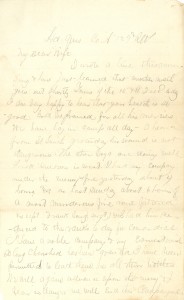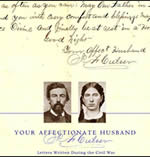 [google-map-v3 width=”400″ height=”300″ zoom=”12″ maptype=”hybrid” mapalign=”right” directionhint=”false” language=”default” poweredby=”false” maptypecontrol=”false” pancontrol=”false” zoomcontrol=”true” scalecontrol=”false” streetviewcontrol=”false” scrollwheelcontrol=”false” addmarkermashupbubble=”false” addmarkerlist=”34.242409, -84.852592{}1-default.png” bubbleautopan=”true” showbike=”false” showtraffic=”false” showpanoramio=”false”]
[google-map-v3 width=”400″ height=”300″ zoom=”12″ maptype=”hybrid” mapalign=”right” directionhint=”false” language=”default” poweredby=”false” maptypecontrol=”false” pancontrol=”false” zoomcontrol=”true” scalecontrol=”false” streetviewcontrol=”false” scrollwheelcontrol=”false” addmarkermashupbubble=”false” addmarkerlist=”34.242409, -84.852592{}1-default.png” bubbleautopan=”true” showbike=”false” showtraffic=”false” showpanoramio=”false”]
Hd. Qurs. Co. “A” 129th Ills.
[Near Cassville, Ga., May 20th 1864]
My Dear Wife
I wrote a line this morning & have just learned that another mail goes out shortly. Yours of the 10th & 11th I recd. to-day.1 I am very happy to hear that your health is so good. God be praised for all his mercies.
We have lay in camp all day. I heard from Lt. Smith yesterday, his wound is not dangerous.2 The other boys are doing well; Fred Huetson is worst.3 I had my Company under the enemy’s fire yesterday about 4 hours,4 and on last Sunday [the 15th] about 6 hours of a most murderous fire, none faltered except Frank Long (Sergt.) & I had him reduced to the ranks to-day for cowardice.5 I have a noble Company & my earnest wish so long cherished has been granted. I have been permitted to lead them in all their battles. We will again advance upon the enemy, & I fear no danger. We will end this Campaign with brilliant and permanent success.
Continue to write often. A letter is a great treat. I scarcely think our letters yet go beyond Chattanooga or Nashville, but you will get them by & by. May God bless you and keep you by his Grace. Remember me to all and accept the love of
Your Affect. Husband
J. F. Culver
Much obliged for the stamps. I have recd. all.
- Mary Culver’s letter of May 10 & 11 is missing fron the Culver Collection. [↩]
- General Sherman’s “army group” had outflanked Johnston’s Army of Tennessee, compelling it to abandon its Rocky Face line and retire into the defenses covering Resaca. The 129th Illinois had marched south by way of Snake Creek Gap, and on the 13th approached Resaca from the west. On May 15 General Butterfield’s division moved to the left and took position in front of the earthworks east of the Dalton road defended by Maj. Gen. Carter L. Stevenson’s division of General Hood’s corps. Orders were issued for Ward’s brigade to attack and storm the redoubt and rifle pits to its front with bayonets. The units formed in battalion column at intervals of 44 paces between regiments—the 129th being the fourth regiment in the column—and prepared to advance. The soldiers shucked their knapsacks and fixed bayonets, and Colonel Case gave the command “forward!” Much of the ground across which the brigade advanced to reach the works defended by Brig. Gen. John C. Brown’s Tennessee Brigade of Stevenson’s division was grown up in dense underbrush. Cannoneers of the Cherokee Georgia Artillery, who had unlimbered their four 12-pounder Napoleons about 80 yards in advance of the breastworks, opened fire on the Federal column with shell at a range of 800 yards. Soon thereafter the bluecoats entered a dense cedar thicket which screened them from view. As the Illinoisans ascended a “small hill about 400 yards” from the Georgians’ guns, they were fired upon by Brown’s Tennesseans posted in the rifle pits. The column charged at the double-quick, the men cheering. There was a change of direction to the right, and the companies on the right, having a shorter distance to go, approached the battery first. General Ward shouted, “Go in boys, give them the devil!” and the soldiers stormed into the “redoubt, which was simply a natural basin on the ridge, with formidable breastworks flanking it on the right and left, and on higher ground.” Sergt. Frederick Hess of Company H, 129th Illinois, placed the colors near the guns of the Cherokee’s Artillery. Brown’s Tennesseans, from their breastworks, blazed away, forcing the storming party to retreat a few steps and take cover in front of the “redoubt.” The four cannon, abandoned by their gunners, were between the lines, and a desperate struggle ensued for their possession. In this fight casualties were heavy; General Ward was wounded; and the Confederates called up reinforcements. Soldiers of Ward’s brigade held the ground gained for five hours, until relieved by General Geary’s division on the night of May 15. Rolls were called. It was found that in the charge and fight for the “redoubt” that the 129th Illinois had lost 9 killed and 39 wounded. The dead were buried on the field next day. Lieutenant Smith had been wounded in the abdomen and shoulder. He was hospitalized until June 4, when he was released from the hospital and given a 20-day furlough. O. R., Ser. I, Vol. XXXVIII, pt. II, pp. 322-323, 340-341, 365-366, Ibid., pt. III, pp. 812-813; Compiled Service Records of Union Soldiers, NA; Grunert, History of the 129th Illinois, pp. 60-62. [↩]
- Frederick G. Huetson, a 20-year-old farmer, was mustered into service on Sept. 8, 1862, as a private in Company A, 129th Illinois Infantry. Private Huetson was wounded in the left leg at Resaca, May 15, 1864, hospitalized at Madison, Ind., and medically discharged at Quincy, Ill., March 25, 1865. Compiled Service Records of Union Soldiers, NA. [↩]
- On the 15th, while the 129th was engaged east of the Dalton road, other Union troops advanced on Lay’s Ferry to the Confederates’ left and rear. With his position at Resaca outflanked, General Johnston, under the cover of darkness, abandoned the works successfully defended for two days and retired south of the Oostenaula. Soldiers of Ward’s brigade on the 16th policed the battlefield, buried the dead, and succored the wounded. The Union dead were buried on a knoll, “the bodies wrapped in blankets and laid along side of each other. Some green twigs were put over the dead, several chaplains addressed the listeners, the grave closed . . . and a board, bearing an inscription the name, number of brigade, regiment, and company of the dead, was placed at the head of each corpse.” That evening the brigade started in pursuit. Next morning the 129th Illinois crossed the Coosawatee, five miles east of Resaca, and turned south. On the 18th an exhausting 20-mile march was made, the column passing east of Adairsville. The day was terribly hot, and many soldiers straggled. Near Cassville, on the 19th, General Johnston prepared to turn on Sherman’s pursuing columns. The Confederate corps commanders botched their assignments, and Johnston pulled back, posting his Army of Tennessee south and east of Cassville. On the morning of the 19th General Ward’s brigade, with other units of Hooker’s XX Corps, formed into line of battle and advanced on Cassville. Ward employed the 105th Illinois, deployed as skirmishers, to cover his battle line. Confederate skirmishers were encountered and forced to retire. The Union advance came to a halt when shelled by a Rebel battery. Taking cover in the timber, the troops threw up breastworks. Here they remained until ordered by General Hooker to move by the right flank to Price’s farm and support the artillery. About 2 P.M., the advance on Cassville was resumed, and four companies of the 129th, one of which was Company A, advanced as skirmishers. Supported by the other six companies, they pressed forward, “driving the enemy from their ambushes and entrenchments until they reached a point less than 1/4 mile from town, and would have penetrated the town had they not been ordered by Gen. (Joseph F.) Knipe to advance no further.” The gallant conduct of the 129th called “forth repeatedly very flattering compliments . . . from Gen. Knipe.” Here they were relieved at dark. O. R., Ser. I, Vol. XXXVIII, pt. II, pp. 341-342, 366; Case to Thomas, May 21, 1864, Regimental Papers, 129th Illinois, NA. [↩]
- Sergeant Long was reduced to the ranks on May 20 and deserted one month later. Compiled Service Records of Union Soldiers, NA. [↩]

 Subscribe via RSS
Subscribe via RSS Subscribe via Email
Subscribe via Email